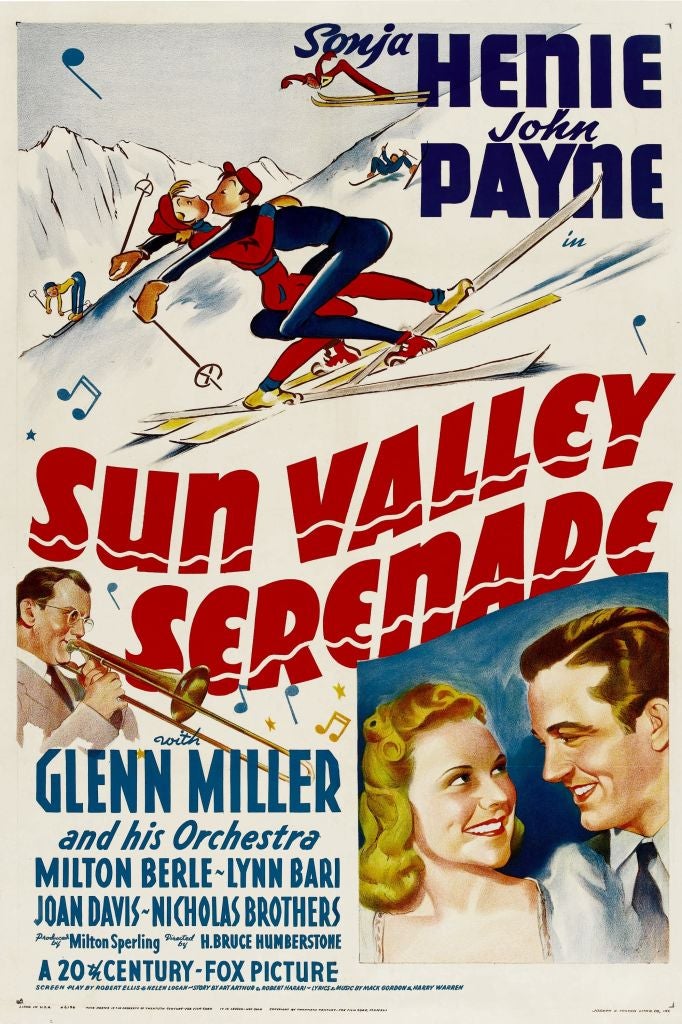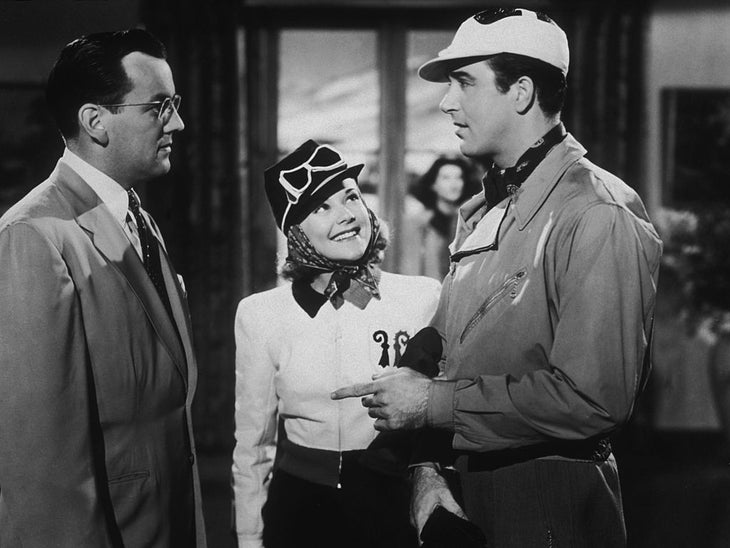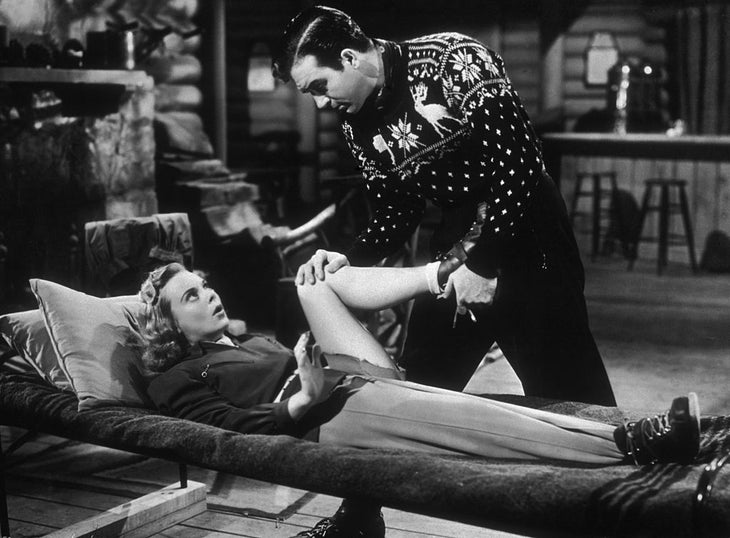Heading out the door? Read this article on the new Outside+ app available now on iOS devices for members! Download the app.
Although one should never underestimate the power of a ski resort to make an impression on a winter tourist, Sun Valley could not have envisioned that one particular visitor to the slopes in 1939 would turn the ski resort into the backdrop of one of the most glamorous films of 20th Century Fox during Hollywood’s Golden Age.
Of course, it helped that the visitor was 20th Century Fox’s studio chief Darryl Zanuck. After visiting Sun Valley, Zanuck went to work on a story that would unabashedly celebrate the glamour of his favorite resort.
The film’s thin plot involves a love triangle that originates with a pianist for the Glenn Miller Orchestra (Ted Scott, played by John Payne) and a primadonna whom the band must court as its lead vocalist (Vivian Dawn, played by Lynn Bari) to ascend the ladder of dance bands. Their romance is interrupted by the intrusion of a Norwegian woman (Karen, played by Sonja Henie) who is shipped to the US in some adopt-an-orphan program that the band’s publicist (Milton Berle) arranged as a publicity stunt. Despite not being the band leader or anyone of crucial musical importance, Ted has to babysit the girl because he’s the lead actor, and the plot demands it.
Even by today’s standards, Karen is a very sexually forward character. She immediately declares her intentions to go husband hunting with Ted as her prime target. This is on par with several screwball comedies — Barbara Stanwyck in The Lady Eve and Ball of Fire, or Katharine Hepburn in Bringing Up Baby–where the female lead runs circles around her befuddled love interest.

For the most part, however, the film exists less as a first-rate story than as a vehicle of sorts for various entities: The Glenn Miller Orchestra approaching the peak of their fame; the figure skating talents of ten-time world champion Sonja Henie; the comedic stylings of Milton Berle, and, last but not least, the glamour of Sun Valley.
Sonja Henie was a triple-Olympic gold medalist from 1928 to 1936 (a feat that has gone unmatched) and won ten consecutive world championships. Born in 1912 as the heiress to the largest fur company in Norway, her parents used family connections to convince 20th Century Fox to sign her up for a contract. While she’s not associated with any essentials in classic films, she was the third highest earner at the box office in 1938, behind only Shirley Temple and Clark Gable. It also helped that Henie cross-promoted her ice skating with a cross-country ice skating tour. Indeed, in the film, Henie has opportunities to show off her skills in a scene that basically doubles as an opportunity to see what all the fuss is about if you don’t get a chance to see her in person.
Milton Berle, the inept sidekick here, enjoyed a show business career that spanned eight decades from his start in 1914 as a child actor in silent films. By the time he starred in Sun Valley Serenade, he had already been a sensation on Broadway and on the vaudeville circuit, where he perfected his stumbling comic persona. Sun Valley Serenade was one of his few movies en route to his foray into TV that would arguably make him TV’s first superstar between 1948 and 1956 with the Milton Berle Show. Berl
Paragraphs could be written about Glenn Miller and the influence of his dance band. The short version is that Miller was a Midwestern who dropped out of the University of Colorado in 1924 to pursue the life of a freelance trombonist and arranger. He organized his first permanent orchestra in 1937, only to disband a year later. It wasn’t until 1939, two years before Sun Valley Serenade, when the orchestra had a residency at the Glen Island Casino that led to radio broadcasts that made them a nationwide sensation. Miller attributed his signature sound to putting some of his sax players (particularly Wilbur Schwartz) on the clarinet, an orchestral instrument that gave him a more sophisticated, continental sound (after all, two of his most popular hits were “String of Pearls” and “Continental Junction”). It’s not so coincidental that he was tapped for a film about a resort that embodied jet-set escapism.
Sun Valley Serenade was Miller’s first film after being contracted to 20th Century Fox. In the film, he plays a minor character as himself. In retrospect, the film is a winking nod to Miller’s longevity because villainous primadonna Vivian thinks the band needs her. In the film, Miller’s lead vocalist, Ted Beneke, carries the main vocal line of the film’s signature tune, Chattanooga Choo Choo. He would make one more film and then feel the calling to support the war effort where he was famously lost in action.
As for how the film helped the band Chattanooga Choo Choo (which also introduced the world to African-American performing pioneers Dorothy Dandridge and the dancing Nicholas Brothers) became the first record to go gold, selling over 1.2 million copies. In the film, Glenn and his fellow trombonists are filmed in Busby Berkley style, which adds to the film’s comedy.
As for the true star of the film—Sun Valley Resort — the film was partially shot on location with shots on the slopes of Sun Valley as the battle of wits between Ted and Karen takes the form of a cat-and-mouse chase. The subtle implication here is that skiing creates emotional bonds: It’s no coincidence that the “other girl,” Vivian, hates skiing, while Ted and Karen are both passionate enthusiasts.
One might be mistaken for thinking that the film was promotional. Promotional newsreels would air in theaters between double and triple features, and many of them would include travelogues about exotic places. At the same time, taking viewers to exotic places has always been an appeal of a film, from the Hope/Crosby Road series at Paramount and Vincente Minnelli’s Technicolor musicals to the Indiana Jones and James Bond films.

Like her father, Sonja was a multi-sport athlete. Writing for Vanity Fair, journalist Laura Jacobs wrote, “ ‘winter drunk’ is how she described the sensation of sledding, skiing, and skating into icy winds.’” Still, Henie had a stunt double on the slopes along with Paine. Ironically, Henie’s stunt double was a 22-year-old local named Gretchen Kunigk Fraser, whose parents also immigrated from Norway. The previous year, she got engaged at Sun Valley’s Harriman Cup, and it was none other than Sun Valley founder Averell Harriman who announced their engagement. Fraser would qualify for the 1940 Olympics, but were cancelled due to the war. After an eight-year wait, when the Olympics were reinstated in St. Moritz, Switzerland, Fraser would get a silver in the combined and gold in the slalom, becoming the first American Olympic alpine medalist of either gender. Her picture adorns the lodge at Sun Valley, and the run “Gretchen’s Gold” is a tribute to her.
John Paine’s stunt double was Hans Hauser, who heads the Sun Valley ski school. However, the greatest success story among the ski staff was likely Ragnar Qvale, who had the good fortune of being assigned as Zanuck’s personal ski instructor during his historic visit. Zanuck hired him as the stunt double for Milton Berle and asked him to teach the extras to ski. He also brought him back to Hollywood as a contract player. He starred in the film Four Sons, but World War II cut short his acting career, and he founded his own architecture firm afterward.
As for the production, the film underwent a lot of complications. with changes in the producers, directors, stars, and screenwriters. Tyrone Power, 20th Century Fox’s handpicked leading man, was set to star at one point opposite Linda Darnell. On the writing end, producer Milton Sperling was credited with the original story outline, and the screenwriting duo of Allan Scott and Bert Granet wrote the original story when it was called Passport to Life. However, Scott and Granet got sidestepped when another duo — Art Arthur and Robert Harari – reworked the story to meet different production demands and got sole story credit. From there, Sperling and the Arthur/Harari duo each were assigned to rewrite the screenplay. On top of that, a different team of screenwriters—Ralph Freed and Richard Carroll—filed a lawsuit that 20th Century Fox plagiarized their story “Pigtails.”

On top of that, Henie held the studio hostage when filming went over by a single day. Since she was contracted for only a few days, she could leave the film unfinished despite being a vital part of the production. She negotiated an exorbitant $225,000 fee for the final day of filming.
The film enjoyed a premiere in Salt Lake City and a secondary one in Atlantic City on August 21. From the movie’s cast, John Payne and Joan Davis, were at the Salt Lake City premiere. They were joined by Brenda Joyce, Marjorie Weaver, and cowboy actor George Montgomery. In addition to state and city officials from Salt Lake City and Utah, the Sun Valley delegation of W.P. Rogers, manager of the Sun Valley resort, and ski school director Friedl Pfeiffer were invited to join in a parade with cast and crew.
“All were greeted in true Hollywood fashion with lights, crowds, cameramen, and radio interviews, outside and inside the theater,” reported the Salt Lake Telegram
Today, the film is played at the Sun Valley Resort’s opera house and runs 24 hours daily in the lodge’s hotel rooms. According to the Sun Valley promotional literature, three other films have featured the Sun Valley region—I Met Him in Paris (1937), Bus Stop (1956), and Pale Rider (1985)—but nothing else has captured the glamour of the ski resort or the ski experience in general as Sun Valley Serenade.